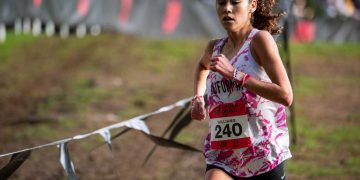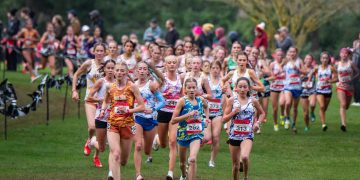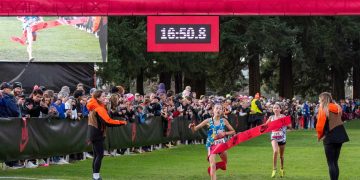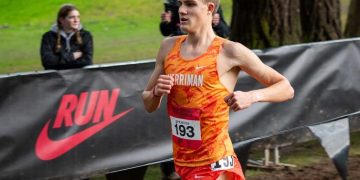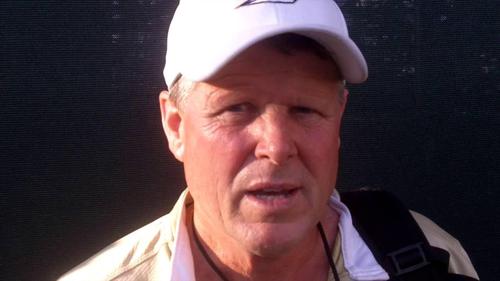 Dennis Mitchell, courtesy of YouTube.com
Dennis Mitchell, courtesy of YouTube.com
David Hunter has been writing for RunBlogRun for nearly five years now, if my memory correctly serves me. A few years ago, I asked David to begin a series on some of the top coaches across the country, and how the skill set to be a successful coach. Coaching is both art and science. David Hunter gets that, and his feature, this feature, on the amazing coach at the University of Akron, Dennis Mitchell, is a perfect example of the amazing men and women who populate our sport, teaching their student athletes how to run, jump and throw, but more importantly, live and thrive in our complicated world.
RelatedPosts
December 28th, 2016
In the summer of 1995, University of North Carolina field events coordinator Dennis Mitchell had just completed his 4th year as a member of the Tar Heels track & field coaching staff, which had guided its UNC athletes to their 3rd straight Atlantic Coast Conference title. Suddenly, Mitchell was presented with the dream of every assistant coach: an opportunity to take on the head coaching duties at a Division I university. But the new position offered by the University of Akron would not be without its challenges. The programs at Akron were woeful indeed. Earlier that spring, the men’s and women’s track & field teams had finished dead last in the Mid-American Conference outdoor championships – both by sizeable margins. The Zips’ programs were in disarray: with few standout athletes; the absence of cohesive program or vision; no real indoor facility; and a subpar outdoor track shoehorned into a gritty urban neighborhood.
To the surprise of many, Mitchell accepted the challenge and took the job. To steel himself for the task ahead, Mitchell frequently reminded himself of the expression he developed with his friend and track & field showman. Bob Fraley. “He and I used to say – and I rarely say this – ‘I could take any program and turn it around, if you just do it right.’ And so when the Akron opportunity came around, I thought, ‘All right, let’s see if I can put my money where my mouth is,’ explains the 57 year old veteran coach. “Akron had the lowest budget; it had the poorest facility; it had virtually no tradition,” recites Mitchell. “People were asking, ‘You’re at a major program. Why are you going there? What’s going on?’ And I told them, ‘I can do it. I can make it happen there,'” recalls the California native. “And I was fortunate because there is one thing I asked the AD when I got here. I told him, ‘I know you don’t have the money – you just don’t have it. All I want from you is just freedom. Just let me do what I want. I expect you to make some decisions, but don’t say ‘No, because…’ Give me a reason when you say no. Don’t just say no because it’s weird. I’m going to come in and do this completely off a different world because that’s all we can do here. I can’t do this based on what another school can do or what’s traditional. I have to figure it out and be creative. I have to find a way.” Two decades and many successes later, no one disagrees: Dennis Mitchell found a way.
When Dennis Mitchell was first introduced to track & field, it was love at first sight. “When I was in elementary school, my 5th grade teacher got me interested in track & field. For some reason, I always just loved track & field. Everything was about that. I just thought it was the greatest thing,” declares Mitchell with enthusiasm. “Eventually, a friend’s family put a pit in their backyard. And he showed me how to pole vault. I was 13 and I just went crazy with that. I built my own pit in my own backyard. I learned on bamboo poles because I couldn’t afford fiberglass yet. I made my own little javelins. Honestly, track was just everything. I just loved the sport.”
In high school, Mitchell’s passion for track & field and his curiosity about every nook and cranny of the sport remained unbridled. “I ran cross country,” explains the eventual pole vaulter. “In the beginning, I saw myself more of a distance runner, to be honest. When I was in school, I would do the hurdles and the long jump – play with everything.” As his passion for the three-ring circus of track & field became more focused – and to the admitted detriment of his school work – Mitchell fueled his obsession with the sport. “I would go to the library and study books on how to pole vault. In high school, I would spend all of my time studying up on track & field stuff, pole vault technique, triple jump form, all facets of the sport,” explains Mitchell as he describes his first thoughts about making the sport his life’s mission. “Probably from the time I first started high school, I said to myself, ‘I want to be a coach. I can do this.’ I was just in love with it.”
The young athlete began his college career at the University of Utah. Already a proficient vaulter upon his arrival, Mitchell was twice the Western Athletic Conference runner-up in the pole vault. Despite his early success, Mitchell knew something wasn’t quite right. Seeking a program that was rooted in tradtition and focused on the vault, Mitchell up and departed to the Texas hinterlands and Abilene Christian University. “Probably the greatest move I’ve made in my entire life,” proclaims Akron’s head coach. “My wife and I were already married then. We were young. We never saw the school. We jumped into the U-Haul, drove 1400 miles, and just went to the campus,” recalls Mitchell of his impulsive move. “Driving through, we said, ‘So this is the place.’ We were out in the middle of the prairie. Once we got to the program and saw the facilities, we thought, ‘OK, this is not too bad.'” Bemused as he remembers his youthful flight to the Lone Star State, Mitchell adds, “Sight unseen, we jumped into the car, we went there, and we took a chance. This is what we’re going to do.” Sometimes – not always – impulsive moves prove correct. This one was. Under the watchful eye of Head Coach Don Hood, Mitchell continued to hone his vaulting craft while contributing to the 1985 ACU’s record point production in capturing the Division II national team title.
As his collegiate career was winding down and aided by a good word from his mentor Hood, Mitchell landed an assistant coaching position at the University of Texas where his vault tutoring produced 4 All-Americans in the vertical jump during his 6 years there. The new post required hard work, long hours, little pay, but provided great experience. “I worked under the great Stan Huntsman,” explains the former Longhorn coach. “Nobody made much money.”
When NCAA rule changes compressed coaching staffs, Mitchell left for Chapel Hill, North Carolina. At the University of North Carolina, the new assistant coach collaborated with head coach Dennis Craddock, eventual NCAA Men’s Indoor Track & Field Coach of the Year, to guide the Tar Heels’ track & field fortunes. “We basically dominated the ACC back then,” explains Mitchell recalling the numerous ACC titles captured by the UNC men’s and women’s squads during his 4 year tenure. “When I came there we started pushing into NCAA prominence. We had stars such as Allen Johnson and Marion Jones. You’re all part of that whole world.”
Mitchell appreciated the experience he was gaining. “Coach Craddock taught me how to work and manage without much budget. I wore several hats there – working with the throwers, the vaulters, and at times the high jumpers – a pretty big group. I was also in charge of their academics, the equipment, putting on our meets. It was literally work, work, work – 80 plus hours a week,” he explains. And with a smile he adds, “I was getting well prepared to become a head coach.”
Mitchell was ready to take the next step. And he knew it wasn’t just the decade of experience that prepared him – it was the quality of leadership under which he served. “I worked with 4 individuals who were eventual Coaches’ Hall of Fame inductees: Don Hood, Stan Huntsman, Dennis Craddock, and Curtis Frye,” exclaimed their protégé. “I got to work under the very best.”
Mitchell soon learned that he would need every aspect of that decade-long, gold-plated experience to successfully address the challenges he would face as the new Head Coach of Track & Field at the University of Akron. Upon his arrival, he first had to deal with the subpar [outdoor track] and non-existent [indoor track] facilities. First of all, Mitchell did what he could with the outdoor facility. “Our outdoor facility completely looked like a prison,” recalls Akron’s coach, shaking his head. “It was horrible. So we raised money to enhance our outdoor facilities.” Next, Mitchell quickly ruled out the improperly-sized, square, rock-hard indoor ‘track’ located in the undersized band-box basketball field house. “I made a rule right away. Nobody is allowed to run on this track. Period. It’s too hard. You’re going to get hurt,” he recalls. But where would his athletes practice during Akron’s brutal winters? “What I did was build a race runway for the pole vault; I bought all these surfaces and cut them to create ‘bays’ for the high jump, the throws, and the sprints. That’s what I meant about ‘being creative.’ Every day we had to set up. And every day we had to tear down. It was just crazy.” It may have been crazy, but Mitchell, his staff, and his team endured – because there was no other way. “We had this philosophy, ‘We’re not going to make any excuses,'” explains the head coach. “We can be successful doing this. We’re going to run regardless. That’s how we’re going to do it.” Just four years later – training under ‘crazy’ conditions – Mitchell’s women athletes captured Akron’s first-ever outright Mid-American Conference track & field team title. And a year later, the Zips’ Christi Smith won Akron’s first-ever national title as she won the NCAA heptathlon championship.
While Akron’s track & field performances were improving, Mitchell – the tireless multi-tasker – was building a coalition of support within the University for the undeniably-needed indoor facility. After much collaboration, cajoling, fund-raising, and political alignment, a viable plan emerged. And in August of 2004, a sparkling new $20 million multi-use field house – featuring a 300 meter, 6-lane Mondo track, a 100 yard astroplay field, throwing cages, jumping pits, and several pole vault areas – was open for business.
The presence of the Stile Field House had the catalytic impact Mitchell envisioned. Before long, the number and quality of athletes eager to come to the University of Akron was on the rise. In addition, the program was blessed when Mitchell and his most competent assistants had success in attracting the very best. A parade of NCAA champions soon followed: Stevie Large [2009 hammer throw], Annika Roloff [2014 pole vault], Shawn Barber [2014-2015 3-time pole vault champion and 2015 world champion], and Clayton Murphy [2016 800m indoors; 1500m outdoors; OT 800m champion; Olympic 800m bronze medalist]. If you build it, they will come. “That facility is the crowning jewel on the campus,” declares Mitchell with pride. “At the time, that was one of the first truly super multi-purpose indoor track facilities. When you walked in there you were just blown away. That was the ‘Wow’ effect.”
Without a doubt, the track & field program at the University of Akron is aided greatly by its terrific indoor facility over the past 12 years. But now, the program is beyond that. It is not just the facility; not just the one or two marquee athletes. With the broad-based excellence of the Zip teams regularly piling up MAC titles for such an extended period of time, the school is developing a genuine heritage of success – a newly-emerging winning tradition which further helps in attracting yet additional good talent.
“Success breeds success. The most important part is to create an atmosphere and build on that,” explains the 21-time MAC Coach of the Year. “You have to work the hardest to get first-string athletes. And once you get that great athlete, then you have to secure about 5 strong athletes per event. And I want #5 to hate being #5 and I want #1 to be scared of #5,’ adds Mitchell. “You have to be in a position to create a competitive energy, not just within your program but also around each event. People see that.” Now in his 22nd season at Akron, Mitchell sees the inspirational impact that his several world class athletes bring to his entire team. “There is no doubt that what Shawn Barber did had an effect on Clayton Murphy. There is no doubt that when those guys get together, you sense this. With their presence, our athletes start to recalibrate what is possible. Once you add in athletes like that, then their teammates start to think, ‘Hmmm. That person is not that much different than I am. I can do that. I train like that. I can do it, too.’ It’s all about creating that culture.”
When Coach Mitchell talks about his plan for further elevation of the track & field program at the University of Akron, you realize he has given his next challenge a lot of thought. “You have to be a complete program. I can’t do what the big schools do. If I try to do what they do and compete with them directly, I’m just not going to always get some of the athletes they do at the beginning,” he explains. “But I can be more creative and smarter about who I get, how I get them, how I make my program an elite program. That’s always been my philosophy.
“How do you crack into that top 10, break into the top 5? How do you do that while at the same time winning a conference title?” asks Mitchell while framing the issue of track as a team sport. “Truly, the most important thing is to win your conference title. My initial goal was to win a conference title, because that is really what team track and field is all about. Some try to be a distance program, or a sprinter program – they try to trick the system. But at the end of the day, winning the conference championship is what the whole, complete team thing is all about. It probably would be easier for me to be a top 10 [national] program by putting all of my resources into just a few events than it would be for me to win my conference title. That to me is just cheating. Because track at the national level isn’t truly a team sport – as it should be. You’re not measured by what the whole team does. You measured by what a few people do,” adds Mitchell with regret. “But when you get into the top 5, or top 4, now you’re starting to get enough athletes that represent some sort of a team.” And with a smile adds, “And that’s the real vision.”
Mitchell is adamant in his views of track & field as a team sport. “When I was at Texas, my first year we lost the national title by 5 points. The team that beat us [SMU] took 7th in our conference. We won the conference that year. Something is not right when that occurs. And we all know it,” states Akron’s head coach. “I want our team to be seen as a complete, whole team that can compete against anyone in the country. And now were trying to take our program to the super elite level. The difficulty we have is trying to get others. We have to be unbelievable with who we recruit – which we have been for a few years. We have to be able to recruit athletes like a Shawn Barber who can realize there is a benefit to going to Akron over other programs,” explains Mitchell who identifies his long range goal as having a reasonable shot – year in and year out – to accomplish a top 10 finish at outdoor nationals without sacrificing the opportunity to compete for the conference title every year.
Over more than two decades at the University of Akron, Mitchell has gone from the daily routine of rolling out and rolling up athletic surfaces to building an ever-rising track & field program that has produced 19 Mid-American Conference track & field team titles, 32 All-Americans, and 5 athletes who have won 8 NCAA championships, a world championship, and an Olympic bronze medal. But success hasn’t spoiled Dennis Mitchell. He remains driven, always thinking about the future, constantly looking for the next facet of the University of Akron program that can be polished, made better. “I’m always looking ahead. My philosophy is, ‘If you’re not building, you’re falling apart,'” proclaims the Zips head coach. “You can’t just freeze time. That’s death to anything. You always have to be building somehow to be competitive.” Not to worry. Everyone knows Dennis Mitchell is not done yet. Dave Hunter
Author
-

Dave Hunter is an award-winning journalist who is a U.S. Correspondent for Track & Field News. He also writes a weekly column and serves as Senior Writer for www.RunBlogRun.com, and covers championship track & field competition domestically and in such global capitals as Moscow, Birmingham, Zurich, Brussels, Beijing, Rio de Janeiro, Zagreb, Ostrava, and Doha. Hunter frequently serves as the arena or stadium announcer for championship track & field gatherings, including the Ivy League, the Big East, the Mid-American Conference, the NAIA, the Big Ten, and the Millrose Games. Hunter has undertaken foreign and domestic broadcast assignments. He ran his marathon P.R. 2:31:40 on the Boston Marathon course back in the Paleozoic Era. To find out more about Dave, visit his website: www.trackandfieldhunter.com He can be reached at: [email protected]
View all posts




